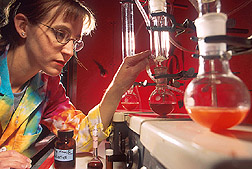This page has been archived and is being provided for reference purposes only. The page is no longer being updated, and therefore, links on the page may be invalid.
|
|
|
|
A Food's Composition, By Any Preparation Method, Is Not the Same
By Rosalie Marion BlissMarch 29, 2007
The method of preserving and testing a particular food sample for nutrient analysis can influence the quantity of bioactive chemicals reported to be found in that food. This is especially important to private and public research laboratories striving to precisely measure compounds in food products that have been found to provide health benefits beyond basic nutrition.
New steps for optimizing sample preservation, analytical preparation and extraction methods for testing the quantity of bioactive phytochemicals in foods have been developed by Agricultural Research Service (ARS) scientists.
The approach was outlined today by ARS scientist Devanand Luthria during the national meeting of the American Chemical Society in Chicago, Ill. Luthria is a chemist with the ARS Food Composition Laboratory, which is part of the Beltsville (Md.) Human Nutrition Research Center. ARS is the U.S. Department of Agriculture's chief scientific research agency.
The steps described included validating sampling, preservation and application of modern extraction procedures, such as use of pressurized liquid and ultrasonic irradiation. These steps support optimal extraction of bioactive phytochemicals from different plant sources. Describing such methods is an important step toward consistency in reporting.
Luthria emphasized the importance of renewed interest in optimized and uniform sample preparation because of the wide variations in quantities of bioactive phenolic phytochemicals reported in foods by different research groups. Accurately quantifying such plant chemicals allows other researchers to determine more precisely the amounts of these compounds people consume in their diets, and to study associations between those intakes and health outcomes.
ARS food composition scientists develop procedures and test methods for accurately analyzing bioactive chemicals in foods. They also provide key data for use in nutrient databases and establishing recommended intakes for nutrients in foods.
Large variations in the quantity of reported bioactive plant chemicals will persist due to differences in cultivars grown, environmental and/or postharvest conditions, and maturity at the time of harvest. But analysts strive to ensure that uncertainty introduced by preparation and analytical methods is small compared to other uncertainties.

